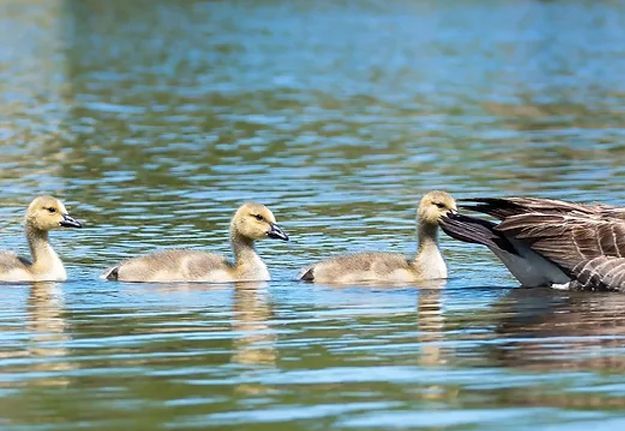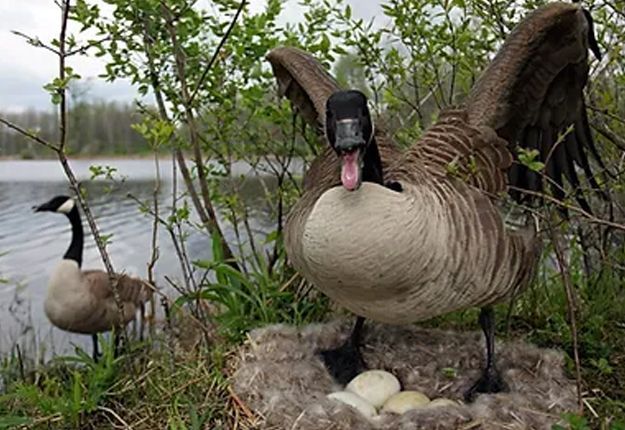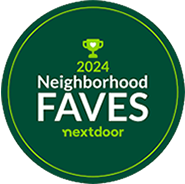Canada Geese Management
Request a Quote
Hero Request Form
About Canada Geese
Branta Canadensis (Canada Geese)
Canada geese range from northern Alaska all the way into parts of Mexico. They are highly adaptable to urban environments and are found in almost all rural and urban environments.
Like all wildlife, they rely on consistent and reliable food sources but must also have access to open water. While Canada geese used to migrate annually to warmer locations, modern land and urban management have made that no longer necessary for their survival.
Long-Term Guests
Cornfields, groomed lawns, and parks provide opportunities for flocks to congregate and become habituated to these areas. Of course, natural water sources are available, but man-made water sources also provide havens for Canada geese. Open water is often found at retention ponds and lakes that have fountains and bubblers running in them year-round.
We have more resident Canada geese in Ohio than ever before due to the management of these water sources. By allowing them to stay open and not freeze over, geese no longer need to migrate in the winter, creating year-round goose populations.
Mating
Canada geese are highly intelligent and have great memories. Geese will deem the area they were hatched to be their “home base” and are habituated to this site for the rest of their life.
Mating occurs during February and March. Generally, they mate for life but may pick up a new mate if something happens to the other. Canada geese are sexually mature at year two and can have up to 13 eggs per season. Once all the eggs have been laid, the female will incubate for 28-32 days. The laying process can take several days, and the female will wait to begin incubation until all eggs have been laid. The male will help defend during this time. During nesting season, the pair will be very protective and aggressive toward anything entering their nesting area.
Nests can be found in mulch beds, the base of trees, tufts of ornamental grasses, flower pots, elevated planters, roofs, and parking lot islands. This can cause big problems if geese are in a location that prevents you from entering your home or customers from reaching your business! In that case, you should consider our goose removal services!
Once the goslings have hatched, there may be anywhere from three to 13 new geese now imprinted on this area as home. The goslings are led to water once hatched, and they stay with the parents and flock for the rest of the year. Occasionally, geese will hatch on a roof or other area where the parents can’t get the goslings to water. TLC Wildlife Management can help in these situations by collecting and reuniting the offspring with the parents in a more suitable location.
Goslings are non-flighted until around August or September. During this time, the adults will also lose their flight feathers in a process called eclipse molting. Canada geese choose to be less active during this time to allow their energy to focus on feather growth. This may be the time of the year when you see a family walking slowly across the road stopping traffic! Because of this, there are certain times of year successful goose mitigation programs should be implemented. The flock will start to fly longer distances toward the end of September, which then allows us to begin convincing them to move on.
The Goose Is a Nuisance and What You Can Do To Help
Canada geese are active in all 88 counties of Ohio year-round. Canada geese can cause poor water quality by increasing coliforms from their droppings. A goose can eat up to one pound of grass a day, and they eliminate up to a pound a day as well! The droppings can cause unusable areas of lawns and parks, as well as slip hazards on sidewalks and parking lots. Aggressive nesting geese can cause injury to people, children, or pets if approached and have been known to attack when they feel their nests are threatened. This can make taking a nice walk around your neighborhood pond a not-so-fun experience!
One thing you can do to help control goose populations is to refrain from feeding geese. Feeding Canada geese can cause imprinting in areas that are not ideal living situations for them. Supplemental feeding is not necessary and can actually cause more harm! This is especially true when feeding bread. The sugars are not able to be digested and used properly and may cause internal issues or angel wings, rendering them unable to fly. If you think you have a sick or injured animal, you can contact TLC Wildlife Management for help. TLC Wildlife Management can assist you with collecting and securing the goose for transport, as well as offer resources for local rehabilitators.

Goslings are hatched in March-May. Aggressive behavior from the defending adults occurs during this time.
Goose Management FAQ
Have a goose-related question? We have the answer. Check out these FAQs and give us a call today for more information!

Adult geese are protecting their nesting territory and eggs. They may chase your staff, visitors, and delivery drivers. Consider prevention prior to this time to reduce negative interactions.
How Can TLC Wildlife Management Help?
TLC Wildlife Management exclusively utilizes humane techniques to help manage and mitigate Canada geese. Mitigation begins with site visits to assess the current state of affairs and determine the size of the initial flock. We then identify nest locations to help monitor numbers and maintain up-to-date data collection.
Harassment of Canada geese is done using a variety of tactics. Dogs like Border Collies are a wonderful tool in controlling goose populations as it introduces a “predator” to the area, which can help them decide that this is not an ideal nesting site. The dogs are NEVER used to catch or injure the geese in any way, only to harass and drive them from unsuitable location. RC boats and lasers may also be utilized.
Another technique we use is egg addling, which is a way to reduce the number of eggs able to develop and hatch. This requires permitting as well as a special set of skills to not harm the geese and should only be done by a licensed professional.
TLC Wildlife Management will provide mapped locations of nest sites and daily reporting to points of contact to keep everyone educated and up to date on progress. We assist with obtaining permits from the Ohio Department of Natural Resources, March acquisitions, and September end-of-season data.
If you have Canada geese nesting in inappropriate locations, making a mess of your yard or property, or harassing residents or customers, give us a call! We
will provide a full site inspection and provide tools and solutions tailored to your specific situation. Call us today or
request a quote on Canada geese management services.









Share On: